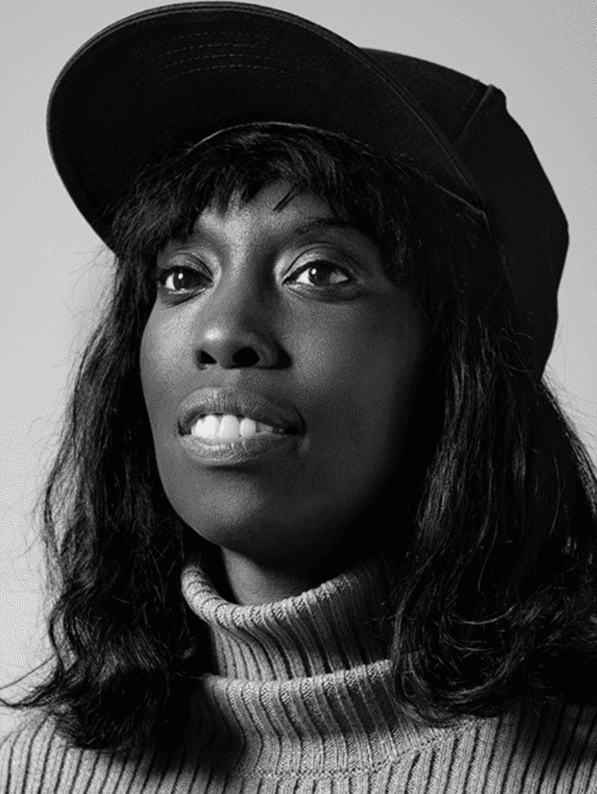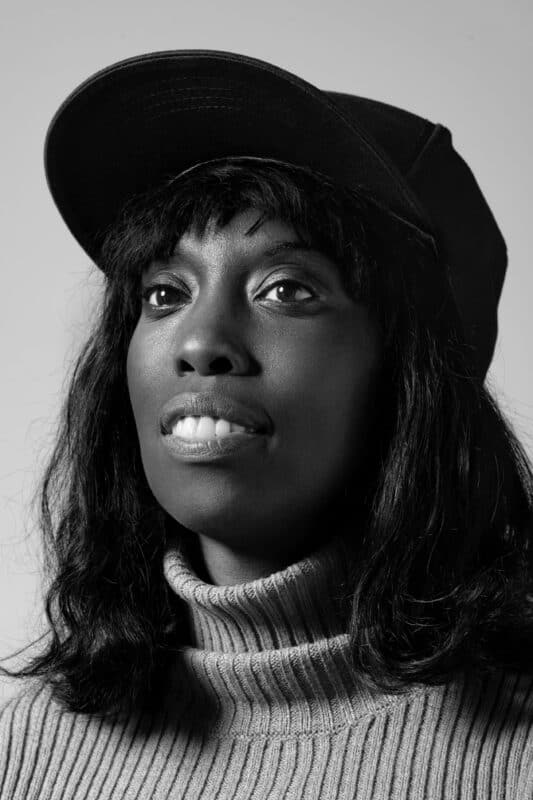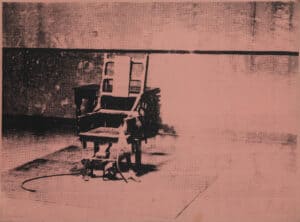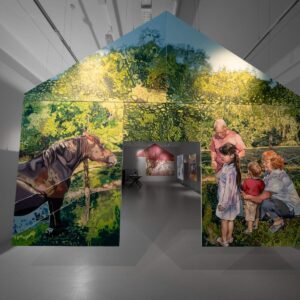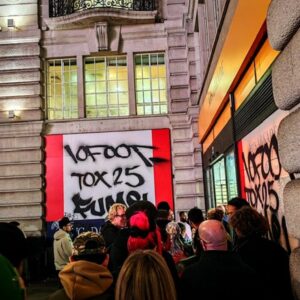“Never trust men in dark suits,” so says the Jorge Luis Borges character in Grace Ndiritu’s 2021 video Black Beauty: For a Shamanic Cinema.
“You mean white men in black suits?,” the clarifying retort coming from Karen Roberts, the interviewer in this velvety ‘70s-style TV talk show.
“Yes, like me I suppose, yes. […] the difference being those specific men tend to pose a lot but deliver very little.”
Borges’ words resonate beyond themselves here. Spoken with a sage-like eloquence, his responses to and conversation with Roberts not only point to the dubiousness of Western ‘rationality’ but allude to something of how this deluded deceit has come to manifest itself within Western museums. That is, how a streamlined understanding of time, which promises so much through its taxonomic tight hold, ultimately drains these institutional bodies of their agential abilities: their power to set minds a-flow and to bring people together across arbitrary differences, thereby offering the potential more ethical futures (to be thought) together. Across two museological sites—the Municipal Museum of Contemporary Art Ghent (S.M.A.K.) and The FOMU Fotomuseum of Antwerp (FOMU)—Grace Ndiritu takes up something of the poetic sentiment flowing beneath Borges’ softly spoken words. Embracing the perspectives afforded through Deep Time, and the intimate conversations that can arise from this fluid way of seeing, across these two sites, Ndiritu aims to renew the potentials of museums by refusing the disembodied sheen of Western linearity.
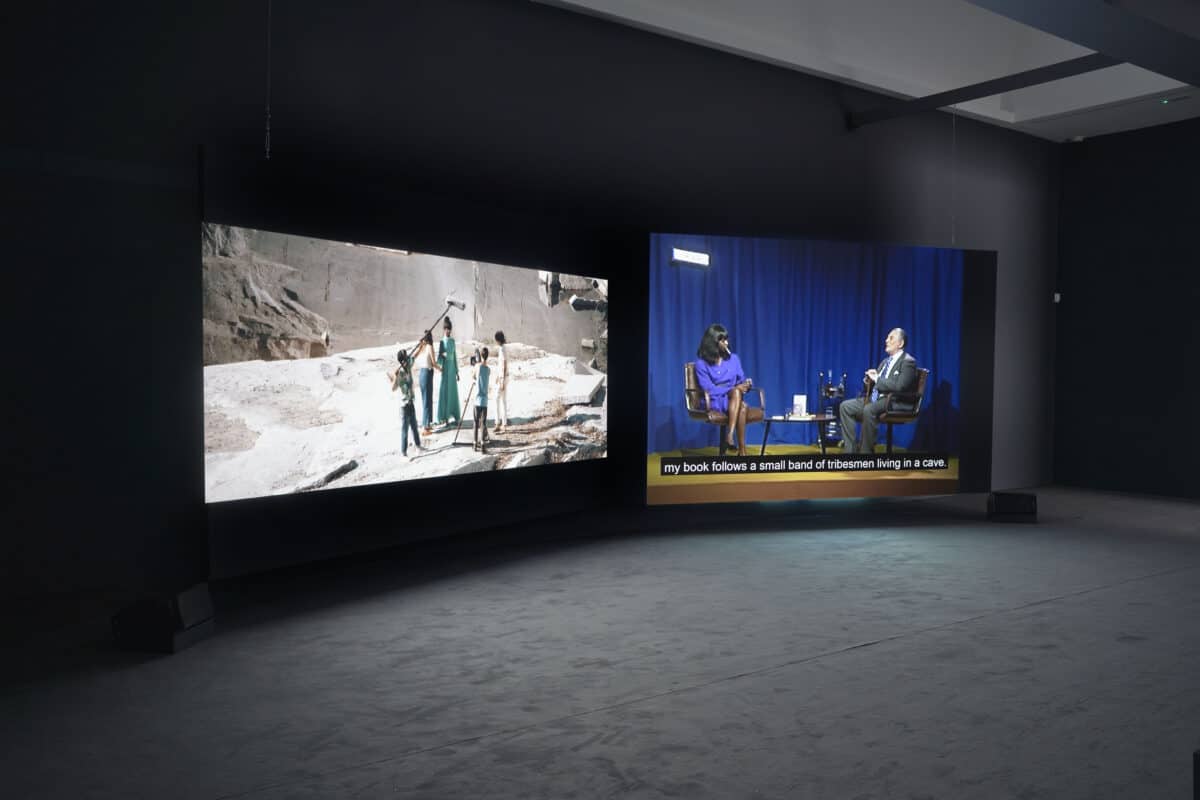
I. Deep Time in the museum
Black Beauty: For a Shamanic Cinema (2021) is a 2-channel video projection. Composed of adjacent clips—the making of a slick Western skincare advert, promising protection from the degradation of the earth, and the fictitious interview referenced above—the video not only opens Ndiritu’s first mid-career retrospective, Grace Ndiritu: Healing The Museum, at S.M.A.K. (until September 10, 2023) but can be seen to diagnose something of the “madness,” to use Borges’ words, that has overcome most museums today: the logic of taxonomic stasis and disembodied consumption; a logic that, when imposed upon wider earthly being, is leading to “all today’s and future problems” (sic). Rather than a chronological ordering of Ndiritu’s practice to date, Healing The Museum materialises as a continuation of the artist’s long-term research project of the same name. Notably, this exhibition is also a moment of public display associated with Ndiritu’s residency at S.M.A.K., itself titled A Spiritual Inventory of a 21st Century Museum, a period of time over which the artist has spent time thinking with staff about how to shape the museum of the future. Pursuing similar threads, through both these projects Ndiritu reflects on the state of museums in our contemporary era. Finding these spaces deeply disturbing, creaking and out of touch, dying! even, Ndiritu aims to re-enliven these vital cultural spaces so they can live, with us, in our present and beyond as ethical institutional bodies able to nurture wider social transformations. Ndiritu enacts this re-enlivening by introducing ‘non-rational methodologies,’ such as shamanism and sharing, into the hallowed, harrowed, often white, space of the museum. Importantly, Ndiritu’s gestures are not spectacular, not sharp, nor shaming. Rather they are wholly communal, inviting. These are gestures enabling conversations which, in turn, dissolve the top-down rigidity so central to the worldly issues arising from the hard linearity of Western thought.
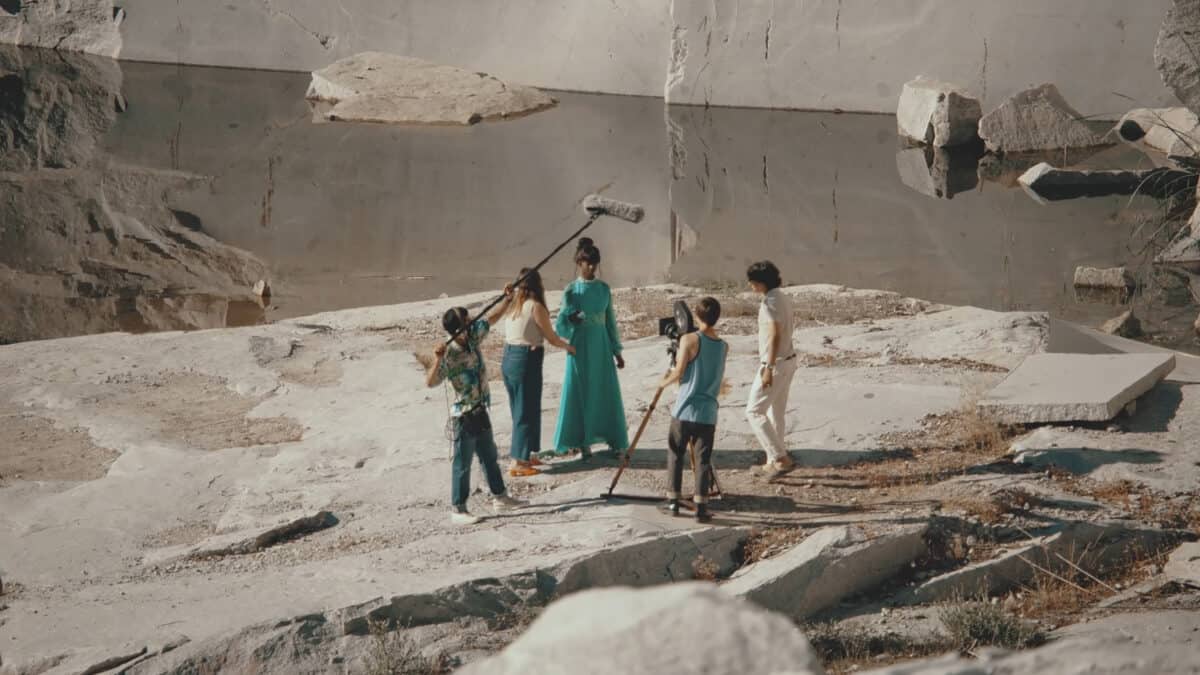
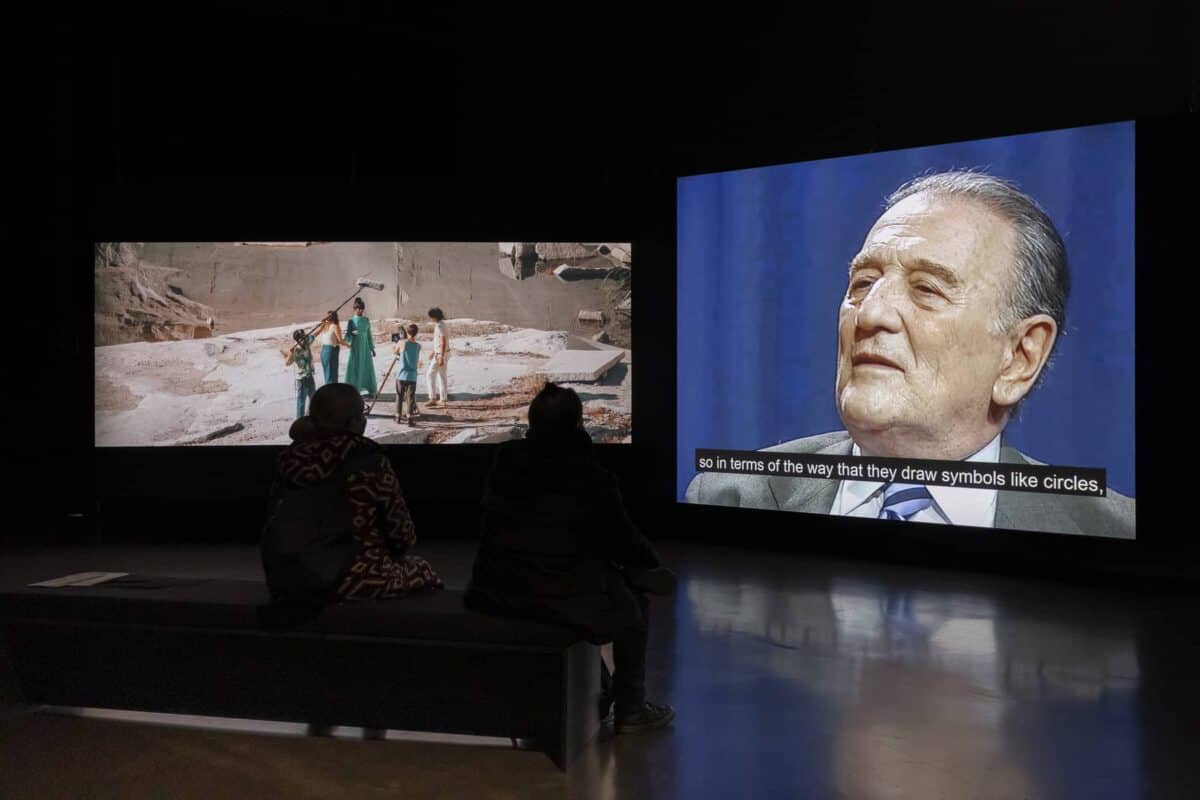
Focusing on Black Beauty’s interview scene, as Roberts and Borges confidently recline across from one another, they discuss Borges’ life and career, his writerly and political perspectives, delving into how his practice subtly, that is poetically, picks at the cauterising issues that appear to be effecting our common abilities to live, both now and in futurity, with and upon the earth. Namely, the pair’s conversation flows in and out of topics such as the difference between the novel and poetic form, the ecological crisis, colonial legacies, the hegemony of Western thought, and importantly, the vital need to think about life through the perspectives of Deep Time. Unlike the ‘rational’ taxonomic stasis of Western Time—the ‘logical’ promise that segregates histories, bodies and beings into tight categories and enclosures, hierarchically stacking these in turn—‘non-rational’ Deep Time thinking privileges an earthly understanding of life; an understanding of life and lives as forms in motion, where times and spaces flow together and flow apart, always remaining in relation despite their fluid proximities. For Ndiritu, the ways of seeing afforded when linear thought is abandoned in favour of Deep Time not only produces new insights into what we share in common but allows new senses of beauty to become manifest. And further, with these sensual materialisations, Deep Time innately produces new states of aesthetic agency, motion and liveness, for both the individual as well as the collective.
As institutional bodies, often composed from cultural materials spanning a range of places and times, museums offer an abundant ground upon which Deep Time perspectives can be nurtured. As Ndiritu’s reflections evidence, too often these body forms are rendered ineffectual by the guiding logic of Western Time. Healing museums, re-enlivening these static corpses, is, therefore, a vital task; one perhaps able to motivate wider socio-cultural, ecological and political transformations. It is a task Ndiritu has set herself with her and here across her two exhibitions in Belgium.
At S.M.A.K., Ndiritu’s installation titled The Temple provides one specific example of how Deep Time perspectives can reorientate—that is, re-enliven—the otherwise static corpse of the museum, by giving the artworks it cares for a renewed sense of communal life.
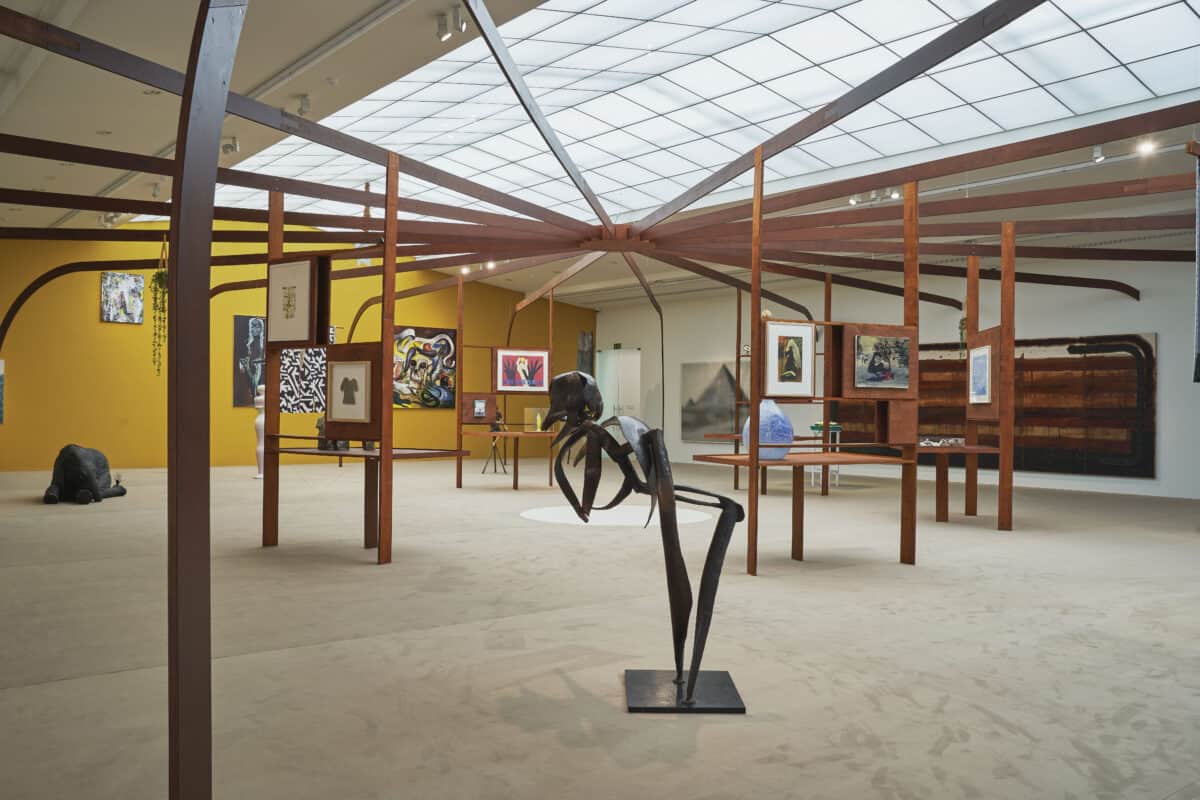
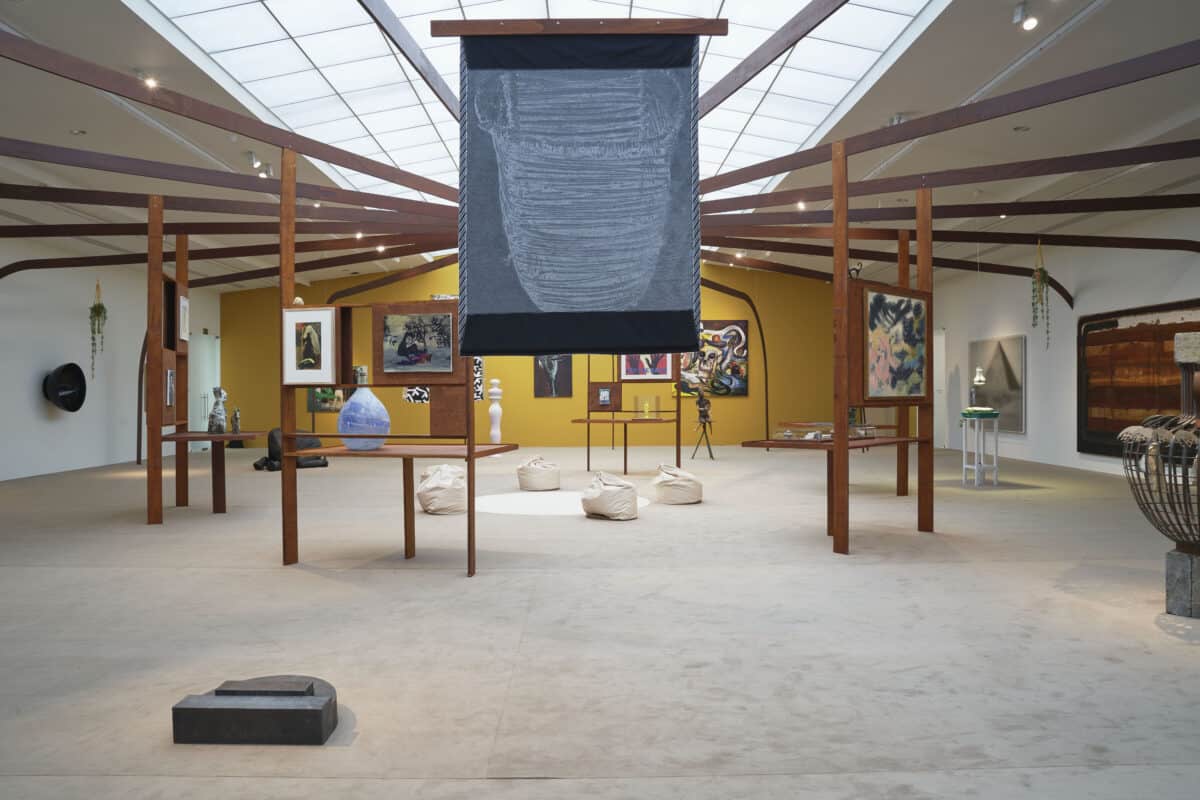
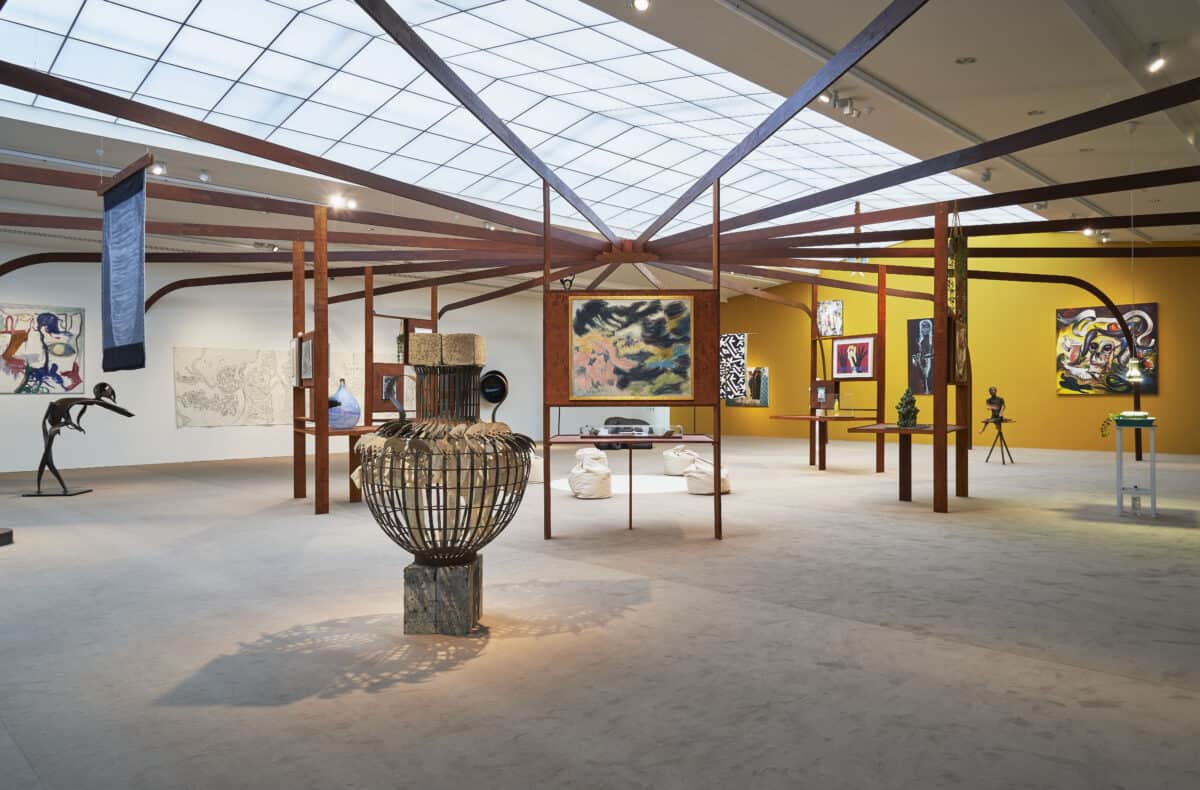
A soul structure (sic), rising high, The Temple materialises as something of a dark-wood rib cage, one that almost surmounts the white walls of its museological surround. Aesthetically, it is a gorgeous vessel, recalling both modernist design as well as indigenous structures built for healing and extra-bodily communing. Working from this structure, Ndiritu displays a selection of artworks from S.M.A.K. ‘s collection in flowing, three-dimensional constellations—across the walls and the floor of the gallery space as well as upon the shelving units that dot the architecture of the wooden dome. Ndiritu’s approach here utterly jettisons the aesthetics that uphold the taxonomies of Western Time: a bare space, a linear hang, the addition of little text appendages, all of which conspire to streamline a viewing experience by stripping an artwork of its agency and abilities to move (physically and metaphorically) beyond its fixed place within hegemonic hierarchy. In this way, the exhibitionary form of The Temple not only expands the energetic space of the museum, but, set within this innately fluid environment, rigid divisions between space and time dissolve. Now freed from the stasis of Western thought, the artworks displayed here gain a new sense of animism, a new lease of agential life. They move beyond meek fixtures in a chain to become individuals able to construct their own lines of thought. Moreover, as these energetic bodies linger in the space, their souls flow in and out of relation, establishing a communal aliveness. Reflecting upon one of the anomalous groupings that compose this ‘non-rational’ hang—a painting and sculpture, that sit upon one of the newly installed wooden shelve structures, and a large drawing mounted to the museum’s wall—I am entranced by how the defiant look of a painterly body, shoulders swaying as they pull themselves out of the waters of a blackened bath, visually rhyme with the grotesque reach of ceramic form, itself rising from the waverly wood-grain patina of its structural setting. And further, how this formal echo reverberates beyond the pairing’s immediate plane, finding an affinity in the large text-cum-topographic map that runs the distant wall behind their newly installed setting.
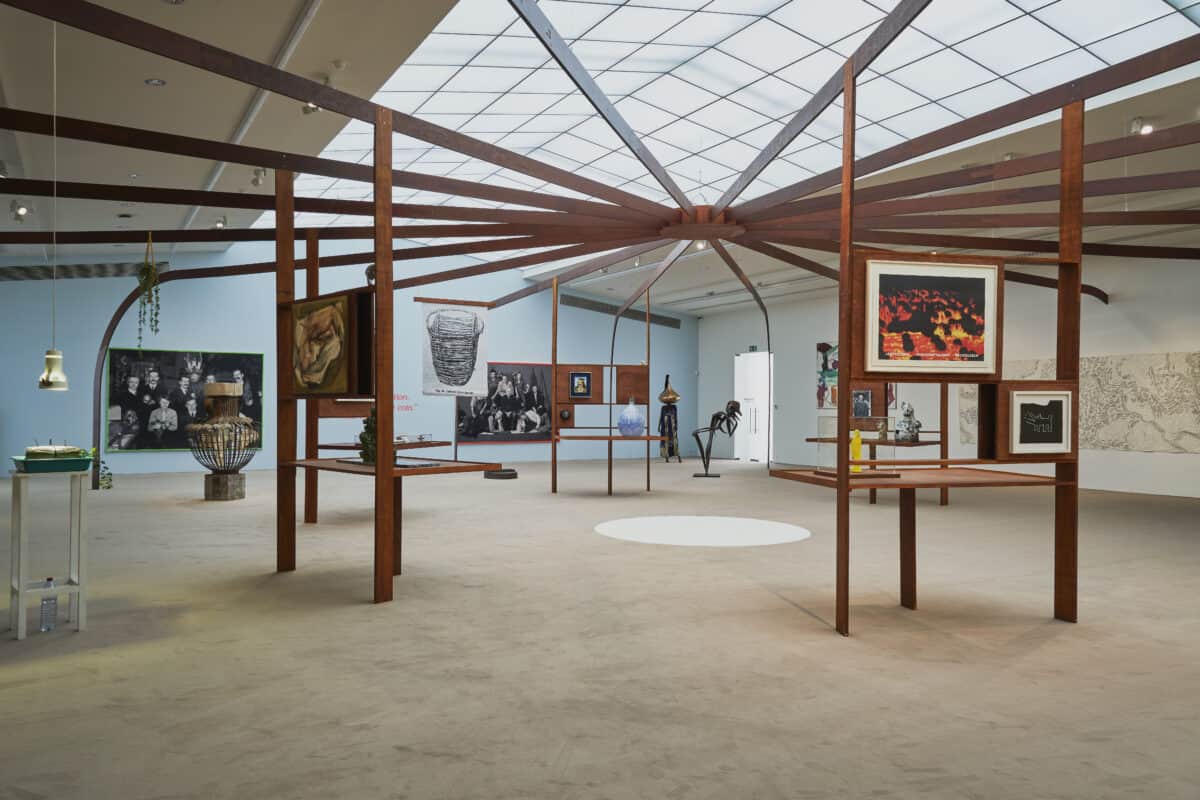
Seen in this way, through Ndiritu’s Deep Time methodology, the museological space gains some level of hapticity; a term used by Tina M. Campt to describe “the labor of feeling across a shared spatiality; communicating and collaborating across differential relationships to space and time; bodies required to feel out, feeling with, across, and through one another to create a sense of intimacy” (sic). By refusing the production line aesthetics of Western thought, Ndiritu allows the artworks shown to become living bodies, bodies that speak and sway, establishing a communing space in turn. That is, in spite of all the material differences so often used by Western Time to foreclose commonality, here, I feel the agency of these artworks and how they invite intimate conversations.
II. Intimate conversationsIt is an invitation to feel. To step beyond plasticky ground and to toe across soft stone carpet. As with her arrangement of S.M.A.K.’s collection, Ndiritu’s solo exhibition Grace Ndiritu Reimagines the FOMU Collection, at FOMU (until January 7, 2024), jettisons streamlined modes of display in favour of conversational feel. Shoes off—a gesture initiated by the artist across S.M.A.K. and FOMU—here, I am welcomed by a homely embrace: a reproduced enlargement of Myron Wood’s 1980 photograph In the Living Room (Georgia O’Keeffe 1887-1986). As the title suggests, Wood’s image shows the modernist living room of Georgia O’Keeffe’s Abiquiú (New Mexico) home. Black and white and beautifully weathered with sepia grains, the scene is warm, a space dotted with artistic gestures, a living space, one welcoming unbridled conversations across formal and aesthetic differences. Here, visual rhymes within the photograph, such as the repeated appearance of bowing white lilie forms—flower, then painting, then dangly lampshade—not only pull me into this softly lit living room but, as I am guided through the image, these rhymes pull me into the homely hued living space of Ndiritu’s exhibition.
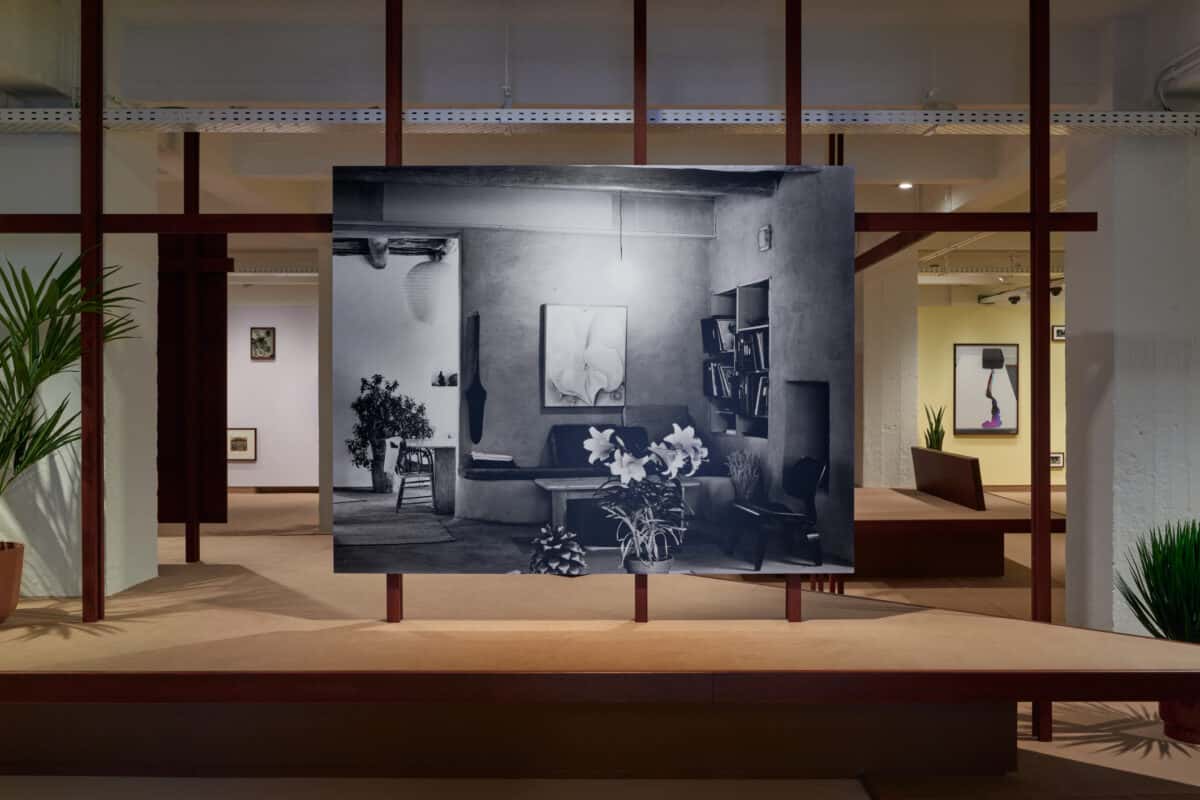
Reimagines draws directly upon Ndiritu’s 2014 photographic installation A Quest For Meaning – Painting as a Medium of Photography. Something of a forerunner to the ‘non-rational’ arrangement seen in The Temple—and indeed those seen in this exhibition—A Quest For Meaning is an idiosyncratic encyclopaedia of images arranged in associative constellations. As with the S.M.A.K. installation, here Deep Time is not only used as a methodological point of departure—to forego rigid Western taxonomies—but as a formal device. That is, as a guiding inquiry ‘a quest for meaning,’ across spaces and times, resounds here through the exhibition’s fluid architecture: a scenography that utilises trellis-like beams and plush benches to create a three-dimensional sensorial universe, something like a modernist nightscape rendered in rich wood and pastel tones.
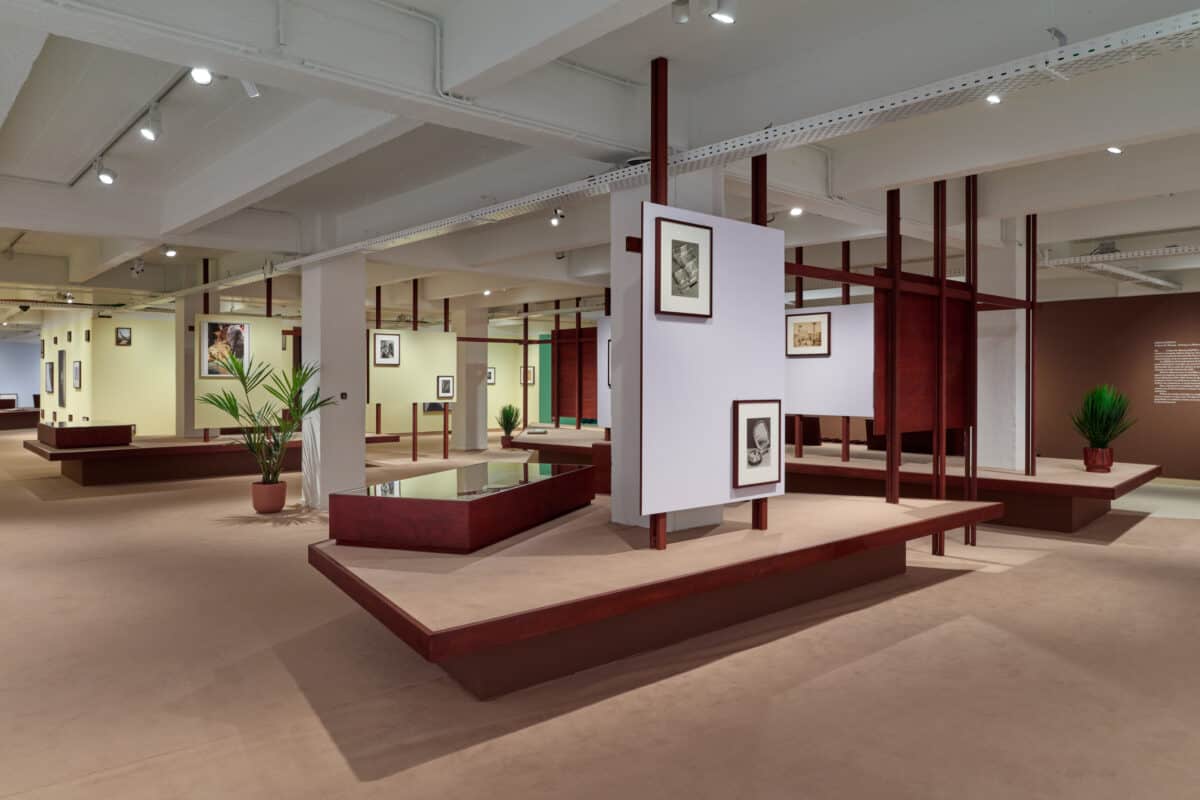
As an artwork, A Quest For Meaning is installed within this exhibition in a small chamber adjacent to the largest display space. Clad in dark wood panelling, the space immediately reminds me of Frank Lloyd Wright designed interiors. Dotted across these beating-grained walls, window-like squares of pure pastel colour are used by Ndiritu to accentuate her idiosyncratic arrangement of photographs—arrangements that use Deep Time as a methodology to bring into relation images that relate to moments in Ndiritu’s life. Pointedly nicknamed ‘Bright Young Things’—perhaps in a reference to the outlandish band of 1930s British socialite stars—these panes not only affuse this modernist space with tingles of colour but become something of a light source allowing me to connect the rhythms rolling out from each of the photographs displayed. Guided by these bright squares, here photographs of interior and exterior lives touch, what is closed echoes that which is open, and as images from differing geo-temporal moments spark off one another, the enclosures of ‘rational thought’ dissolve, suffusing the whole exhibition space with an intimate atmospheric.
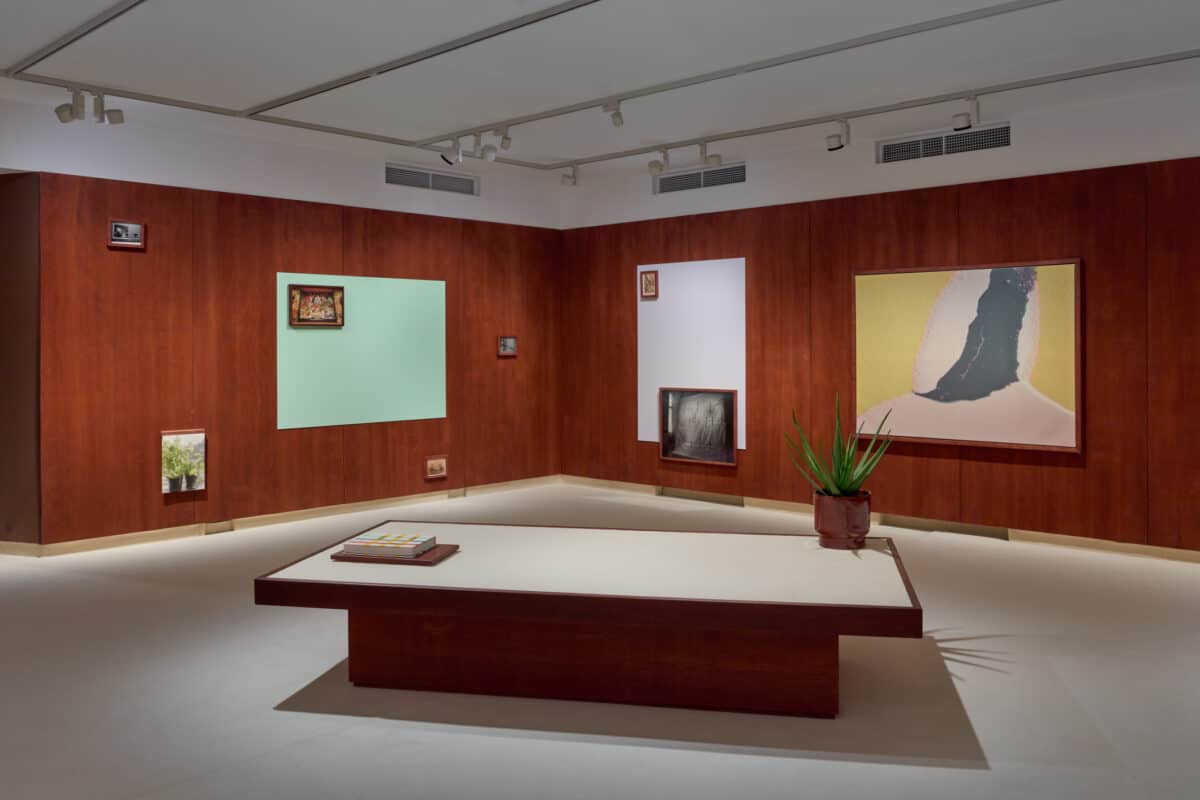
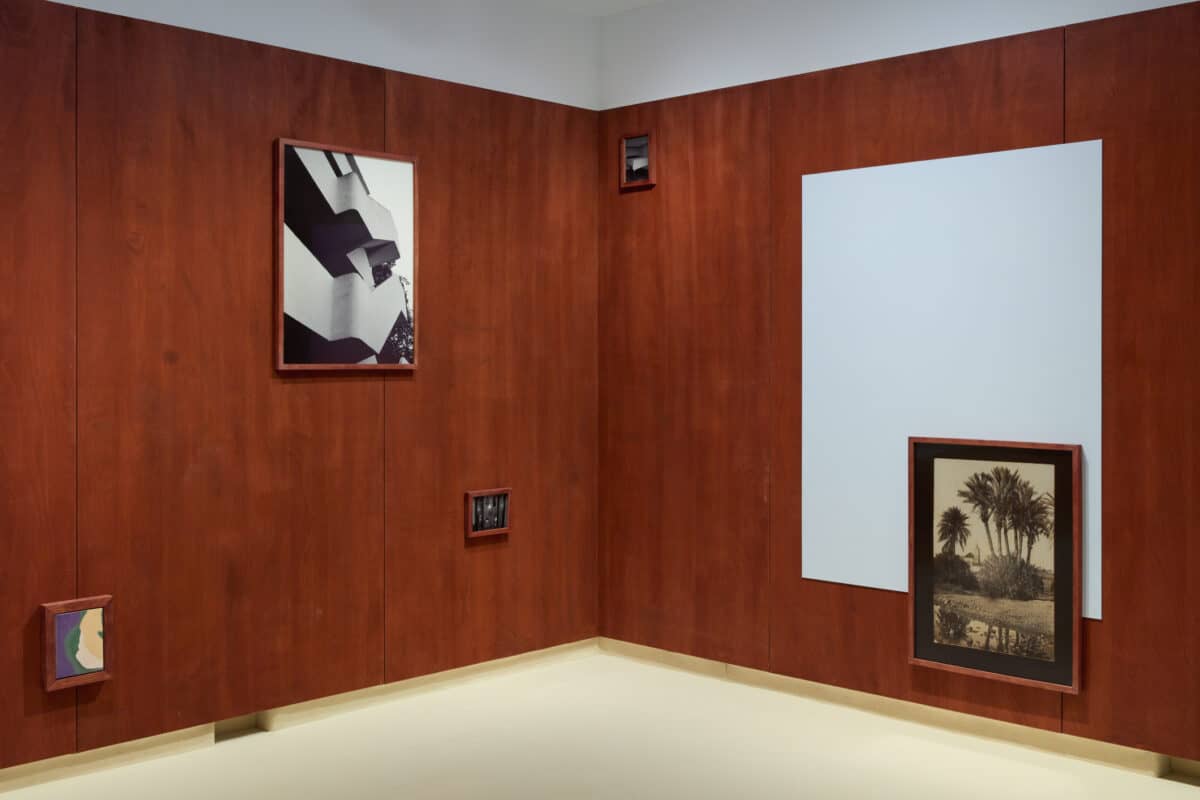
As I flow from the Lloyd Wright-esque chamber into the otherwise photographic universe that composes Reimagines, I feel this air as it hangs in and as the exhibition space. Composed from a number of colour-coded constellations, each referencing a possible way to organise FOMU’s collection based upon Ndiritu’s own ‘non-rational’ categories, Reimagines is itself a loose collection of stars; dissipated forms that not only invites my eyes but which require me to feel beneath the surfaces of each of these otherwise flat photographs—seeing them as living beings. That is, rather than staring mutely at the skin of each photograph, searching for meaning by scrutinising a tile, date, or location, here I am invited to meander through and/or to sit in comfort amongst these constellations and to create meanings across these differing photographed forms—to hear them chatter. (As a note, none of the photographs in these constellations include images of creaturely lives—no animals, insects, nor human presences can be seen within these images—we are the only bodily protagonists in this collection reimagining.) Indeed, as well as having a denser hang, one of the main differences I feel between this rearrangement and that seen at S.M.A.K. is my own sense of constitutional agency. Rather than being a witness or respective listener, sensing the aliveness of artworks, here I feel more like the Roberts character in that late-night TV interview: a key protagonist active in the creation of a loose cosmological narrative—a fluid, co-developed narrative. Further, as I slowly move through the exhibition space, I am taken by how my movements fundamentally progress this embodied conversation. That is, how through my roaming, I am able to enter into a space of shared conversation, one where the space between glimmering glass wear and sunlit archival architectures becomes infused by a few footsteps and the subsequent sound of hollow dew drops flanked by desert winds.
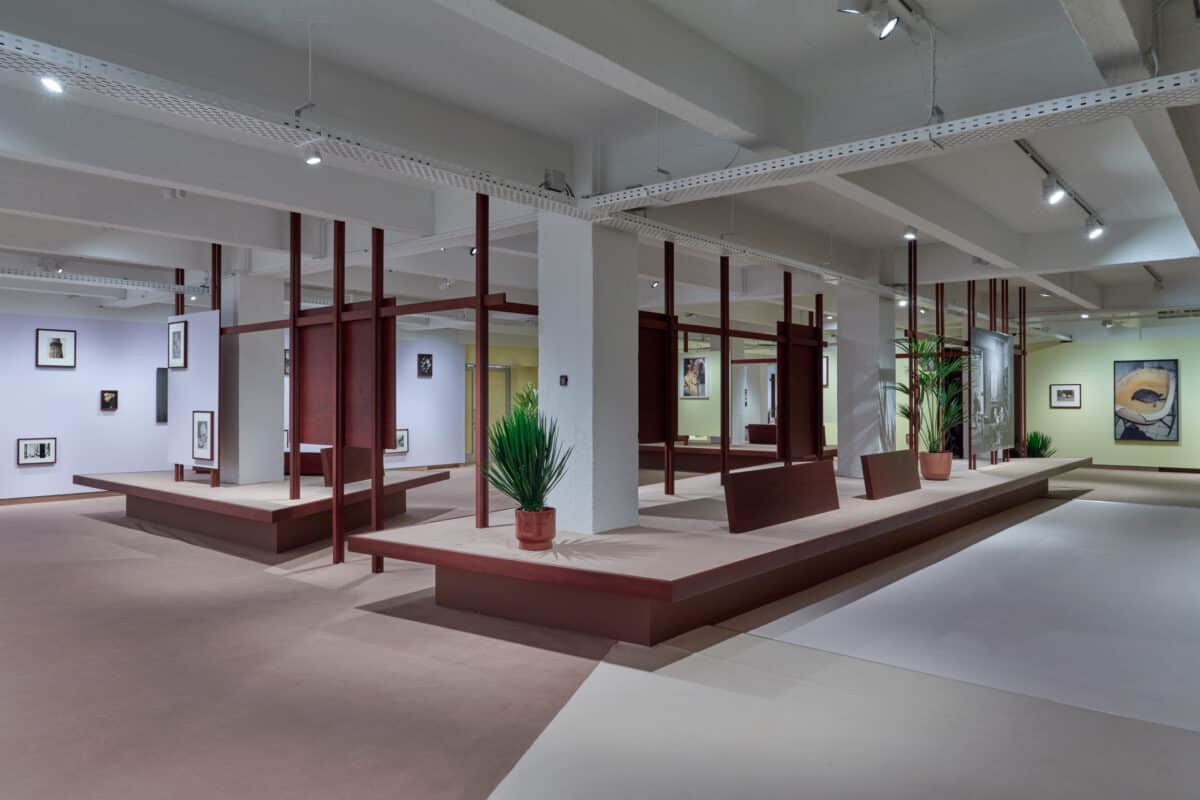
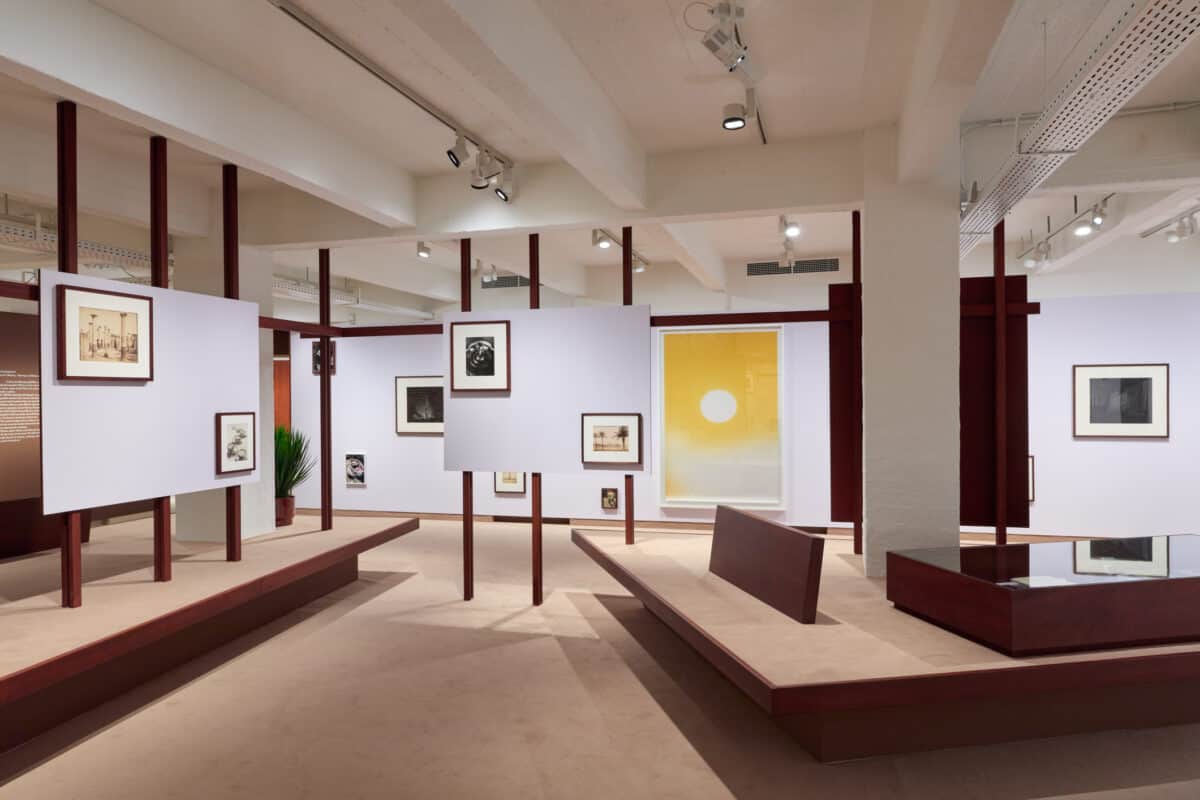
Returning to Ndiritu’s motivations to re-enliven museological spaces, so they are able to be co-agents in the creation of more ethical societies, Reimagines transforms FOMU’s collection from a space of static surfaces, something streamlined, into an enlivening environment, one effusing hapticity. Feeling in, and importantly a key constituting part of, the Deep Time universe abounded by Ndiritu, this exhibition arouses in me a moving sense of shared spatiality: an intimacy that, like a homely environment, allows critical and creative conversations to happen. Further, zooming out, as with Borges’ poetics, across both her solo exhibitions in Belgium, the velvety textures of Ndiritu’s installations speak beyond themselves. These wonder-filled constellations abound the fixity of an artwork, as set by Western time, literally reorienting the vision of the museum body in turn, and thereby allowing these spaces to become vital sites of conversation, sites of commune, free from the false promises of sharp-suited thought.
Grace Ndiritu Healing The Museum, The Municipal Museum of Contemporary Art Ghent (S.M.A.K.) – 10th September 2023 smak.be/en/exhibitions/grace-ndiritu
Grace Ndiritu Reimagines the FOMU Collection, The FOMU Fotomuseum of Antwerp – 7th January 2024 fomu.be/expos/grace-ndiritu-reimagines-the-fomu-collection
